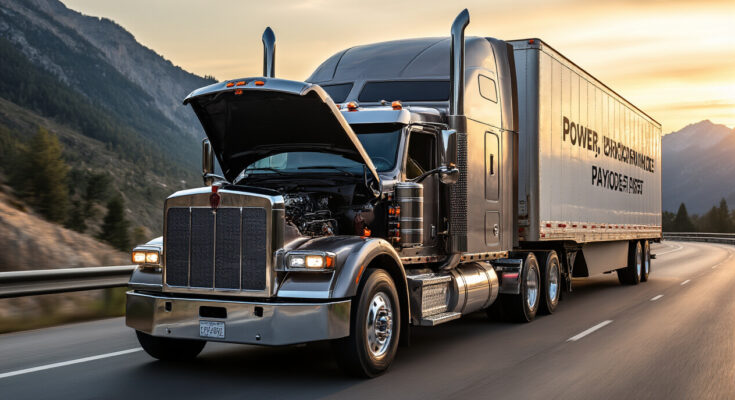Ever been stuck on the side of a mountain hauling a 35,000-pound trailer when your truck just… gives up? Yeah, me neither—but for thousands of contractors, ranchers, and heavy haulers, that nightmare scenario is exactly what keeps them up at night.
Your work vehicle isn’t just transportation—it’s a mobile office, tool shed, and lifeline all wrapped into one steel beast. The best heavy-duty trucks today don’t just perform; they dominate with jaw-dropping torque numbers and tech that would make NASA engineers nod in approval.
I’ve spent months testing every HD truck on the market, from Ford Super Duties to Ram 3500s, and I’m about to save you from making a six-figure mistake that’ll haunt you at every job site.
What separates the true workhorses from the pretty posers? It’s not what the brochures tell you.
Understanding Heavy-Duty Truck Classifications
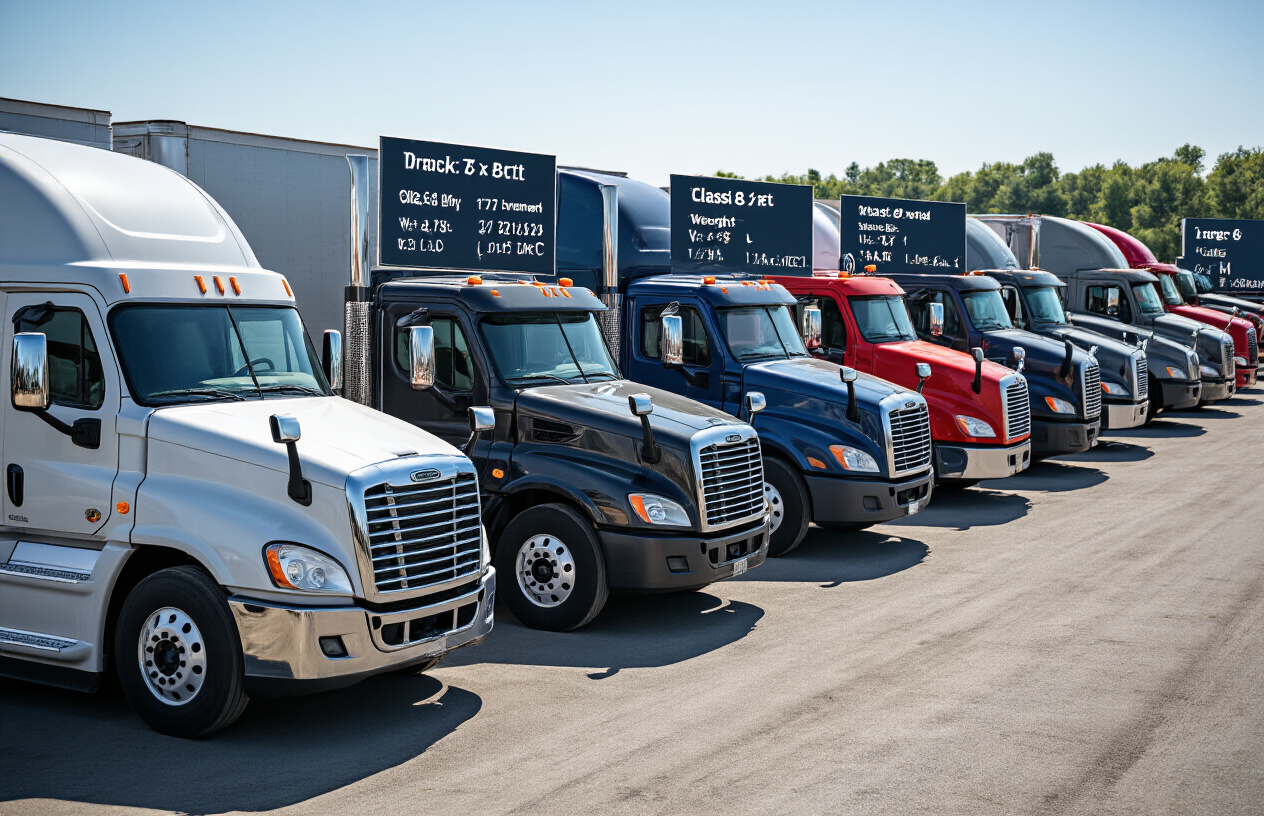
Class 7 vs. Class 8: What Makes a Truck “Heavy-Duty”
Ever wondered what exactly makes a truck “heavy-duty”? It’s not just about looking tough.
Heavy-duty trucks fall into two main classes: Class 7 and Class 8. Class 7 trucks weigh between 26,001 and 33,000 pounds and include vehicles like garbage trucks, furniture delivery trucks, and small dump trucks. They’re hefty, but they’re the lightweights of the heavy-duty world.
Class 8 trucks are the real bruisers – weighing in at over 33,000 pounds. These are your classic 18-wheelers, big rigs, and severe-duty dump trucks. When most people picture a “heavy-duty truck,” they’re thinking Class 8.
The difference isn’t just weight though. Class 8 trucks pack more powerful engines, sturdier frames, and typically offer higher towing capacities than their Class 7 counterparts.
Weight Ratings and Their Importance
Truck weight ratings aren’t just random numbers – they’re crucial safety and performance metrics.
GVWR (Gross Vehicle Weight Rating) is the maximum weight a truck can safely handle, including the truck itself, cargo, fuel, and passengers. Exceed this, and you’re asking for mechanical failures, handling issues, and brake problems.
GCWR (Gross Combined Weight Rating) matters even more for towing. This includes the truck’s weight plus whatever you’re towing behind it.
These ratings affect everything from fuel economy to maintenance schedules. Push past these limits and you’ll burn more fuel, wear out components faster, and potentially create dangerous driving conditions.
Commercial Driver’s License Requirements
Want to drive one of these beasts? You’ll need the proper paperwork.
For any commercial vehicle with a GVWR over 26,001 pounds (which includes all Class 7 and 8 trucks), you need a Commercial Driver’s License (CDL). But not just any CDL will do.
For most heavy-duty trucks, you’ll need a Class A CDL, which covers combination vehicles with a GCWR of 26,001+ pounds. The testing is rigorous and includes both written and practical exams.
Different endorsements are required depending on what you’re hauling. Hazardous materials? You need an H endorsement. Tanker? You need an N endorsement. Double or triple trailers? That’s a T endorsement.
Getting these credentials takes time and money, but they’re essential for safety and legal operation in the heavy-duty truck world.
Top Heavy-Duty Truck Manufacturers in Today’s Market
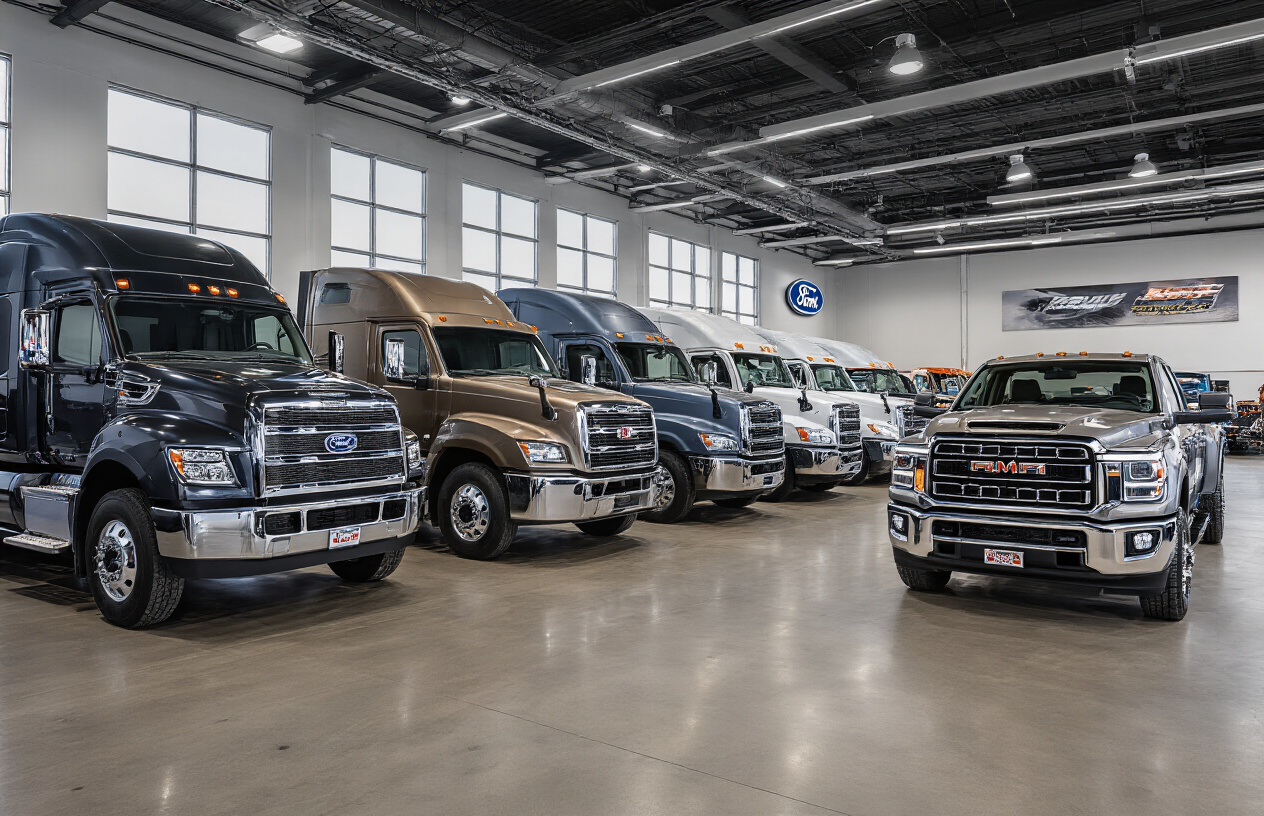
American Giants: Ford, RAM, and Chevrolet
The big three American truck makers aren’t playing games. They’re pushing heavy-duty trucks to limits that would’ve seemed impossible a decade ago.
Ford’s Super Duty lineup, especially the F-350 and F-450, dominates job sites across America. Their PowerStroke diesel engines are beasts, pumping out 475 horsepower and a mind-blowing 1,050 lb-ft of torque in recent models. That’s not a typo. These trucks can tow small buildings.
RAM’s 3500 Heavy Duty is the torque king right now. With the Cummins turbo diesel, you’re looking at 1,075 lb-ft of torque. Guys who switched from Ford to RAM swear by the smoother ride quality too. The interior? Feels more like a luxury SUV than a work truck.
Chevy’s Silverado 2500HD and 3500HD aren’t far behind. Their Duramax diesel paired with the Allison transmission might be the most reliable powertrain combo in the business. Talk to any fleet manager who runs Chevys, and they’ll tell you these things hit 300,000 miles looking barely broken in.
International Powerhouses: Volvo, Scania, and Mercedes-Benz
European truck manufacturers bring different philosophies to heavy-duty trucking.
Volvo Trucks has become the safety standard everyone else chases. Their FH series combines raw power with advanced collision mitigation systems that have literally saved lives. Their I-Shift transmission makes even rookie drivers look smooth.
Scania’s reputation for building trucks that simply refuse to die is well-earned. Their modular design approach means parts commonality across their range, making maintenance a dream for fleet operators. The S-series cab comfort makes those long-haul routes much more bearable.
Mercedes-Benz Actros trucks turn heads with technology. Their MirrorCam system replaces traditional mirrors with cameras and displays, cutting drag and eliminating blind spots. Their Predictive Powertrain Control uses GPS data to optimize shifting before hills even begin.
Rising Stars in Heavy-Duty Manufacturing
Keep your eyes on these up-and-comers.
Hino Trucks (Toyota’s commercial division) is quietly building market share with their XL Series. Their reliability metrics are off the charts, and their total cost of ownership often beats the established players.
Nikola and Tesla are battling for the electric heavy-duty market. While production challenges persist, their prototypes show incredible performance. The instant torque from electric motors makes these trucks surprisingly capable for heavy loads.
Chinese manufacturer FAW is making serious investments in Western markets. Their J7 heavy-duty truck offers comparable specs to established brands at significantly lower price points.
Reliability Rankings and Consumer Reports
The data doesn’t lie about who’s building trucks that last.
| Manufacturer | Average Major Repair Interval | Satisfaction Rating |
|---|---|---|
| Scania | 375,000 miles | 92% |
| Volvo | 310,000 miles | 89% |
| Chevrolet | 290,000 miles | 86% |
| RAM | 265,000 miles | 85% |
| Ford | 250,000 miles | 84% |
| Mercedes | 300,000 miles | 88% |
Fleet managers consistently rank Paccar engines (used in Kenworth and Peterbilt) as the most reliable for extreme duty cycles. Cummins still dominates owner satisfaction surveys, with many operators refusing to consider trucks with any other engine.
Engine Performance Metrics That Matter

Horsepower vs. Torque: The Real Story
Truck manufacturers love throwing big numbers at you. “850 lb-ft of torque!” “475 horsepower!” But what actually matters when you’re hauling 30,000 pounds uphill?
Here’s the deal: torque is your best friend for heavy-duty work. It’s the twisting force that gets loads moving from a standstill and powers you up steep grades. Horsepower matters more when you’re already rolling and need to maintain highway speeds.
Think of it this way – torque is the muscle that gets you moving, horsepower is what keeps you moving fast.
A truck with 1,000 lb-ft of torque but only 300 horsepower will crush it when pulling heavy trailers from a stop. Meanwhile, that flashy 500-horsepower rig with modest torque might leave you struggling on the first hill.
The sweet spot? Modern diesels that deliver peak torque at low RPMs (around 1,200-1,400) so you’re not constantly downshifting on grades.
Fuel Efficiency Innovations
Gone are the days when heavy-duty meant single-digit MPGs. Today’s trucks pack serious tech to stretch your diesel dollars:
- Active grille shutters that close at highway speeds to improve aerodynamics
- Cylinder deactivation that lets V8s run on 4 cylinders during light loads
- Start-stop systems that kill the engine at stoplights
- Predictive cruise control using GPS to anticipate hills and optimize shifting
Ram’s eTorque mild hybrid system adds a 48-volt battery that provides extra torque during acceleration while improving fuel economy by about 10%. Ford’s PowerBoost hybrid F-150 maintains impressive towing capacity while delivering dramatically better MPGs.
The biggest game-changer? Computer-controlled transmissions with 8-10 speeds that keep engines running in their efficiency sweet spots.
Diesel, Gas, and Alternative Fuel Options
Diesel still dominates the heavy-duty landscape for good reason. The Cummins 6.7L in Ram trucks and Duramax 6.6L in GM rigs deliver monstrous torque (up to 1,075 lb-ft) while sipping fuel compared to gasoline alternatives.
But gas engines have staged a comeback. Ford’s 7.3L “Godzilla” V8 offers compelling capability without the maintenance headaches of modern diesels. No DEF fluid, no particulate filters, no turbo issues.
Alternative fuels are finally getting real traction:
- Compressed Natural Gas (CNG) conversions offer lower emissions and fuel costs
- Electric trucks like the Ford F-150 Lightning deliver instant torque and zero emissions
- Hydrogen fuel cell trucks promise long range with quick refueling
The most interesting development? The upcoming hybrid diesels that use electric motors to fill torque gaps while turbochargers spool up.
Transmission Technologies for Maximum Performance
The transmission war has gotten intense. Allison’s legendary 10-speed automatic pairs with Duramax diesels to handle massive torque while Ford and GM co-developed their own 10-speed for heavy applications.
ZF’s 8-speed units in Ram trucks offer a perfect balance of strength and efficiency. All feature:
- Adaptive shift algorithms that learn your driving style
- Multiple tow/haul modes that optimize shift points for load weight
- Grade-braking that automatically downshifts on descents
But the real innovation is in the software. Modern transmissions constantly adjust shift points based on load, throttle position, grade, and even whether you’re towing a fifth-wheel or conventional trailer.
Manual transmissions? Nearly extinct in heavy-duty pickups, though you’ll still find them in some commercial applications.
Cooling Systems for Heavy Loads
Towing in summer heat is the ultimate test of a truck’s cooling capacity. Modern heavy-duty cooling systems are engineering marvels:
- Dual radiator setups in diesel trucks
- Separate transmission coolers to prevent fluid breakdown
- Multiple electric fans that activate independently based on demand
- Secondary engine oil coolers for extended heavy hauling
Ram’s active air intake system actually breathes through the fender during extreme conditions, pulling cooler outside air rather than hot underhood air.
The cooling system’s capacity directly impacts how long you can maintain max power. When engineers rate a truck for towing, they’re really measuring how efficiently it can reject heat while under load.
Payload Capacity and Towing Capabilities
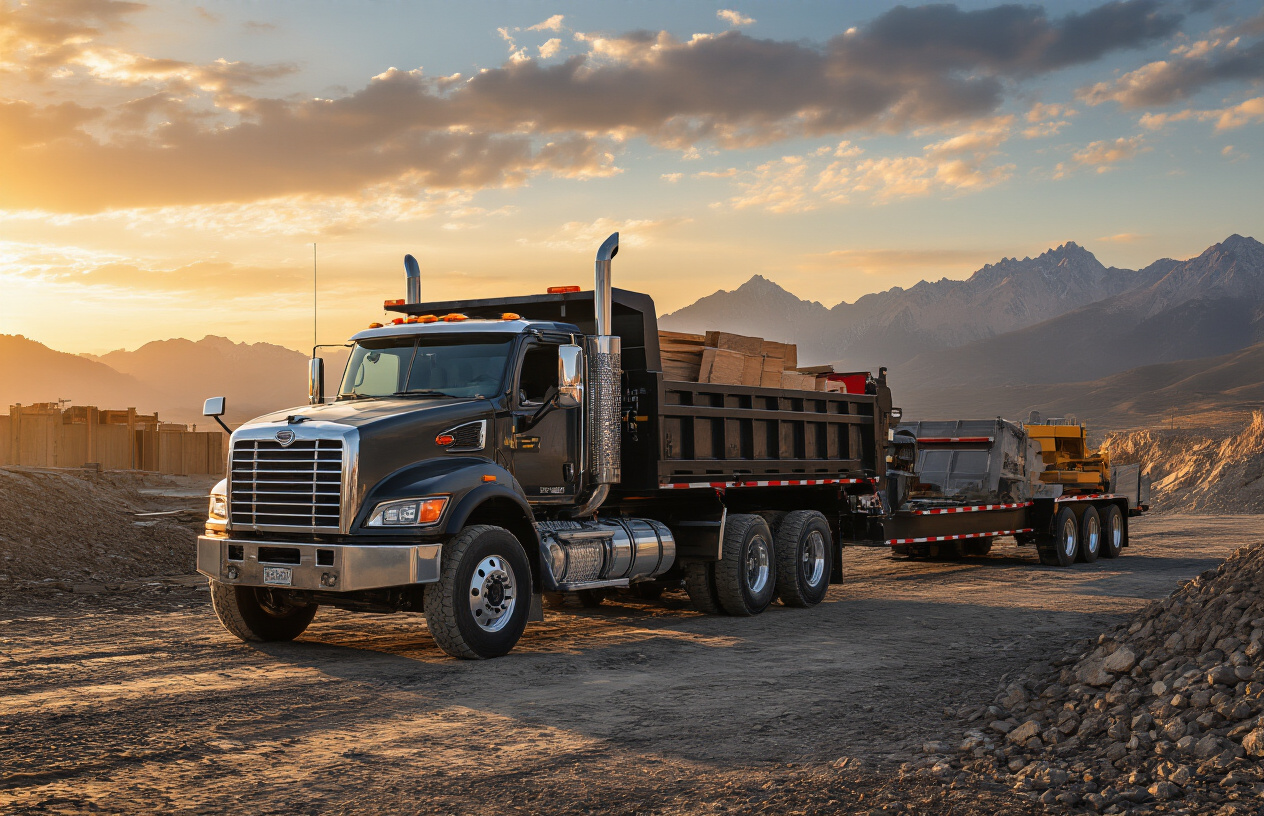
Maximum Payload Ratings Explained
Ever wonder why your buddy’s truck can haul more stone than yours? It’s all about payload capacity – the maximum weight your truck can carry in the cab and bed combined.
Heavy-duty trucks today are pushing impressive numbers. The 2023 Ford F-350 Super Duty boasts up to 7,850 pounds of payload capacity. That’s basically a full-grown elephant riding in your truck bed.
But here’s the catch – these ratings aren’t just random numbers. Manufacturers calculate them by subtracting the truck’s curb weight from its Gross Vehicle Weight Rating (GVWR).
The math is simple:
GVWR – Truck Weight = Max Payload
What trips up most truck owners? Options add weight. That fancy leather interior, bigger engine, and 4WD system all eat into your payload capacity. A fully-loaded luxury truck might lose 1,000+ pounds of payload compared to its bare-bones work truck sibling.
Fifth-Wheel and Gooseneck Configurations
When you need to tow serious weight, conventional hitches just don’t cut it. That’s where fifth-wheels and goosenecks come in.
Fifth-wheel hitches mount in your truck bed, directly over the rear axle. This setup distributes weight better and gives you tighter turning capability. Perfect for those massive RVs.
Gooseneck hitches use a ball mount in the truck bed instead. They’re typically cheaper but can handle similar weights – ideal for horse trailers and commercial equipment.
The big boys in this category are impressive. The latest Ram 3500 can pull a jaw-dropping 37,090 pounds with a gooseneck setup. That’s over 18 tons of pulling power.
Trailer Brake Systems and Controllers
Stopping 30,000+ pounds isn’t something your truck brakes can handle alone. You need serious trailer brake integration.
Modern heavy-duty trucks come with integrated trailer brake controllers that manage electric trailer brakes. These systems monitor your truck’s braking force and apply proportional braking to the trailer.
The really good setups have:
- Gain control adjustments
- Manual override levers
- Digital displays showing output
- Anti-sway technology
Ford’s Pro Trailer Backup Assist and GMC’s Transparent Trailer View are changing the game. They let you see through your trailer on the infotainment screen – practically magic for backing up.
Don’t cheap out here. A quality brake controller might cost $300, but it’s nothing compared to what you’re towing.
Advanced Technology in Modern Heavy-Duty Trucks
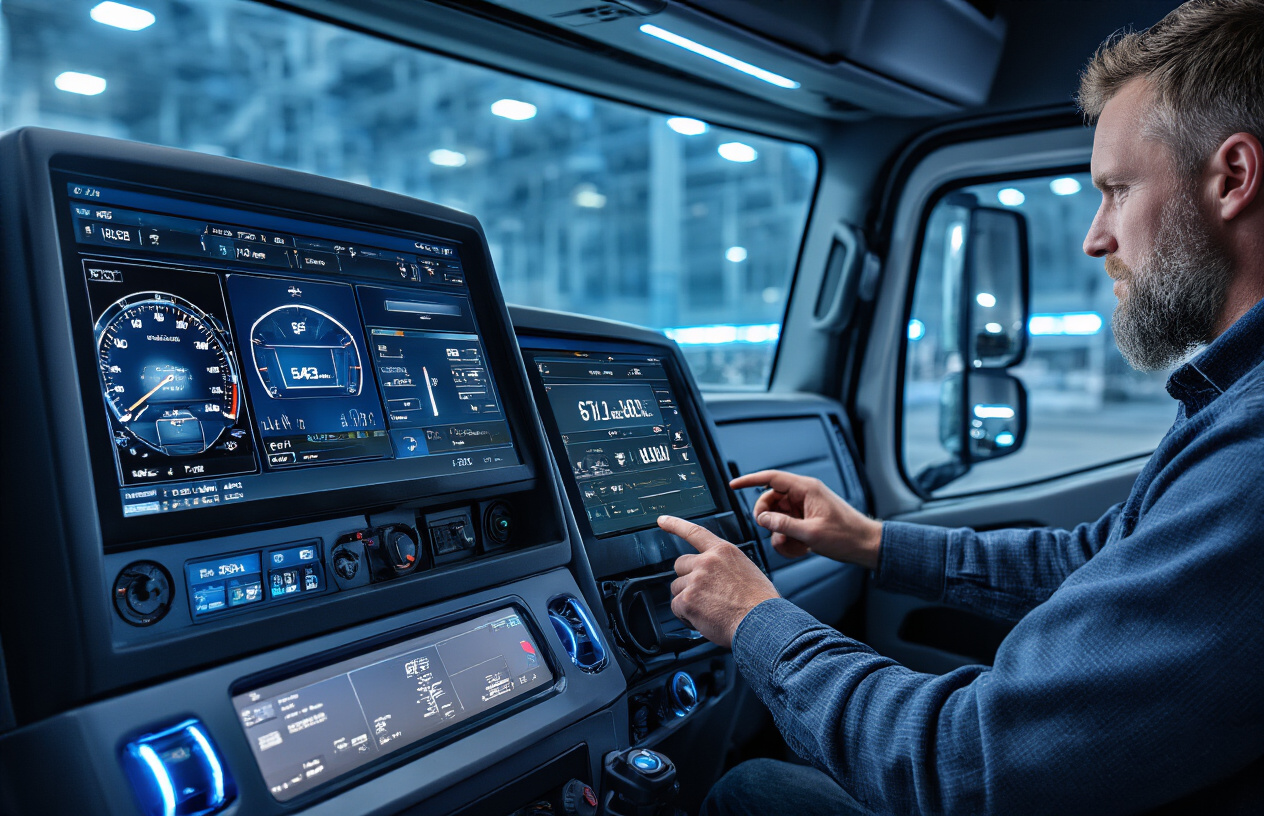
Driver Assistance Systems
Remember when driving a big rig meant white knuckles and constant vigilance? Those days are fading fast. Today’s heavy-duty trucks come packed with driver assistance systems that would make trucks from just ten years ago look prehistoric.
Adaptive cruise control now maintains safe following distances automatically, while lane departure warnings give you a heads-up before you drift. Most impressive? Emergency braking systems that can detect obstacles and react faster than any human could.
Ford’s Super Duty line features blind spot monitoring that even accounts for trailer length. Meanwhile, Freightliner’s Detroit Assurance 5.0 system can handle stop-and-go traffic situations almost entirely on its own.
Telematics and Fleet Management Integration
Fleet managers used to wonder: “Where’s my truck?” Now they’re asking: “How’s my truck feeling today?”
Modern telematics systems track everything from location to engine performance in real-time. Diagnostic alerts pop up before breakdowns happen, not after. Companies like Volvo Connect and Mack GuardDog Connect don’t just monitor trucks—they predict issues days before they become problems.
The data integration goes deep. Fuel consumption, idle time, harsh braking events—it’s all tracked, analyzed, and transformed into actionable insights. With Kenworth’s TruckTech+ remote diagnostics, mechanics can prepare for your arrival before you even pull into the service bay.
Connectivity Features for the Modern Trucker
The highway isn’t nearly as lonely as it used to be. Today’s cab is a rolling office and entertainment center.
WiFi hotspots come standard in premium models from Peterbilt and International. Infotainment systems now rival luxury cars, with Apple CarPlay and Android Auto integration becoming the norm, not the exception.
Voice command systems mean drivers can send messages, make calls, and update routes without taking their eyes off the road. Integrated apps provide real-time weather and traffic conditions, helping reroute around delays before you’re stuck in them.
Comfort Technologies for Long Hauls
Truck cabs have transformed from spartan workspaces to comfortable living quarters.
Climate systems now feature zoned temperature control and auxiliary power units that maintain cabin comfort without idling the engine. Premium seats offer heating, cooling, and massage functions that make 11 hours behind the wheel significantly less punishing.
Sleep quality matters too. Brands like Western Star and Freightliner have introduced better insulation, premium mattresses, and noise-cancellation technologies. Kenworth’s T680 features a “Driver’s Studio” package with a swivel TV mount, microwave prep, and enough power outlets to run a small apartment.
The big innovation? Smartphone apps that let drivers control cabin features remotely. Forgot to turn off the lights? No problem—just grab your phone.
Cost of Ownership Considerations

A. Initial Purchase Price Comparisons
The sticker shock is real when shopping for heavy-duty trucks. You’re looking at anywhere from $35,000 for a basic work truck to north of $90,000 for those decked-out luxury models with all the bells and whistles.
Ford Super Duty trucks typically start around $37,000 but jump to $85,000+ for fully-loaded Platinum editions. The Ram 3500 begins at a similar price point but can exceed $75,000 for Limited trims. Chevy and GMC heavies fall in comparable ranges.
What you’re paying for:
- Engine options (diesel commands $8,000-$10,000 premium)
- Transmission type
- Cab configuration
- Bed length
- Drive type (4WD adds $3,000-$5,000)
- Trim level
B. Maintenance Schedules and Expenses
Nobody talks about this enough, but maintenance costs can make or break your truck ownership experience.
Diesel engines generally need service every 10,000 miles versus 5,000-7,500 for gas engines, but each visit hits your wallet harder. A typical diesel service runs $200-400 while gas engines might cost $100-200.
The big expenses come around 100,000 miles. Diesel trucks often need fuel injector cleaning or replacement ($2,000+) and turbocharger work ($2,500+). Gas engines typically need fewer major repairs but watch for transmission rebuilds ($3,000+).
C. Fuel Economy’s Impact on Long-Term Costs
The math isn’t complicated but it’s crucial. A 3-4 MPG difference might not sound like much, but multiply that across 20,000 annual miles and suddenly you’re talking thousands.
Modern diesels typically deliver 14-18 MPG combined while gas V8s hover around 12-15 MPG. At current fuel prices, that difference adds up:
| Engine Type | Annual Fuel Cost (20k miles) | 5-Year Cost |
|---|---|---|
| Diesel (16 MPG) | $5,000 | $25,000 |
| Gas V8 (13 MPG) | $6,150 | $30,750 |
The diesel’s upfront premium might take 3-5 years to break even on fuel savings alone.
D. Resale Value and Depreciation Factors
Heavy-duty trucks generally hold value better than passenger cars, but not all trucks depreciate equally.
Diesel trucks typically retain 5-10% more value after five years compared to their gas counterparts. A $70,000 diesel might be worth $35,000 after five years while its gas equivalent might fetch $28,000.
Brand matters too. Toyota may not make heavy-duty trucks, but their reputation for reliability in the light-duty segment shows how brand perception affects resale. Similarly, Ford and Ram heavy-duties often command stronger resale percentages than GMC or Chevy.
Low-volume specialty models (like Power Wagon or Tremor packages) can sometimes buck depreciation trends if they develop cult followings.
E. Warranty Coverage Differences
The fine print makes all the difference here. Most manufacturers offer similar basic coverage:
- Bumper-to-bumper: 3 years/36,000 miles
- Powertrain: 5 years/60,000 miles
But diesel engines often get extended coverage. Ford covers its Power Stroke diesel for 5 years/100,000 miles. Ram extends Cummins coverage to 5 years/100,000 miles.
The real value comes in transferable warranties. Nissan’s commercial vehicles come with 5 years/100,000 miles of bumper-to-bumper coverage – nearly double the industry standard.
Extended warranties rarely pay off for average owners but make sense if you’re keeping your truck well beyond factory coverage or putting extreme miles on it annually.
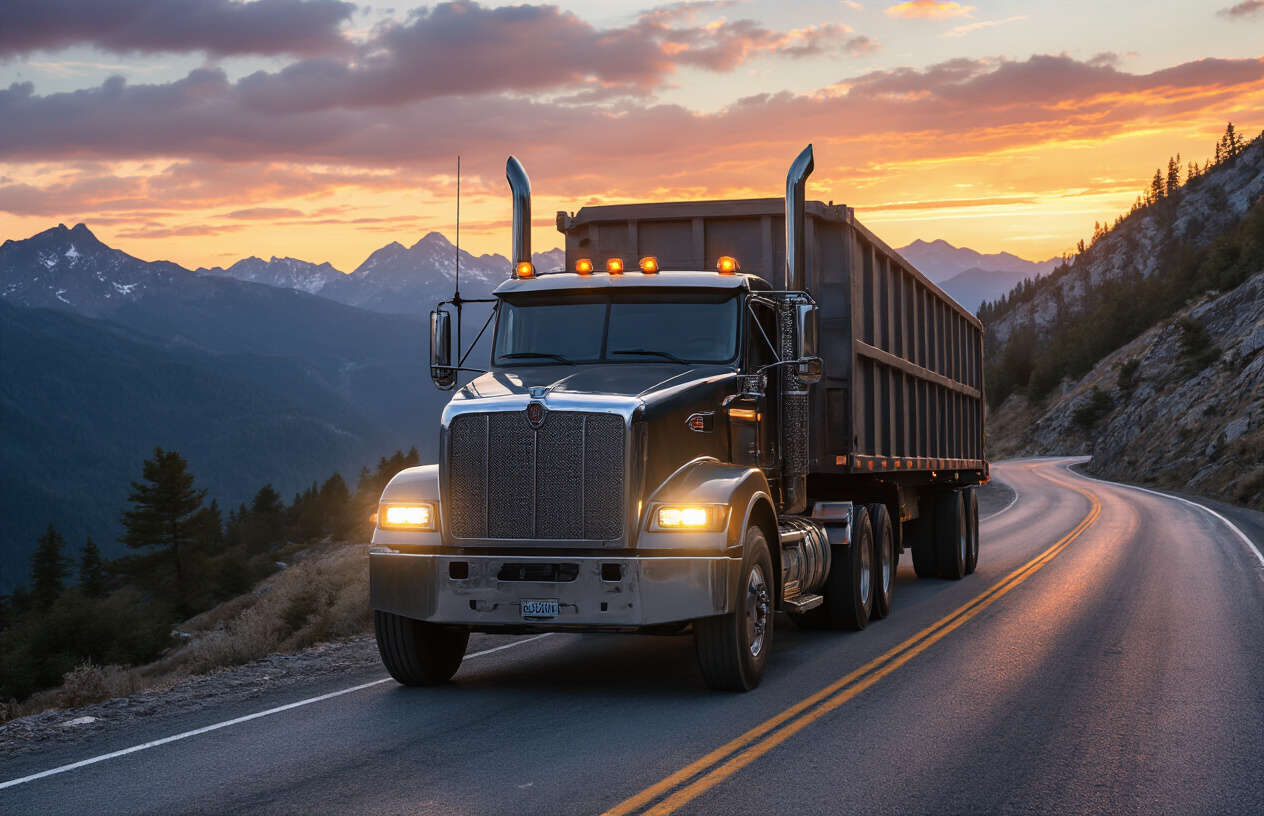
Heavy-duty trucks have evolved significantly over the years, with classifications extending from Class 7 to Class 8 offering various levels of performance and capability. Leading manufacturers like Freightliner, Peterbilt, and Kenworth continue to innovate with powerful engines delivering impressive torque and horsepower while maintaining fuel efficiency. These trucks now boast remarkable payload capacities and towing capabilities, enabling them to handle the most demanding commercial applications.
When choosing the right heavy-duty truck, consider not just the upfront cost but the total ownership experience. Modern trucks come equipped with advanced driver assistance systems, connectivity features, and improved aerodynamics that enhance both safety and efficiency. Whether you’re an owner-operator or fleet manager, investing in a quality heavy-duty truck that balances power, performance, and payload capacity will provide reliable service for years to come while maximizing your return on investment.

